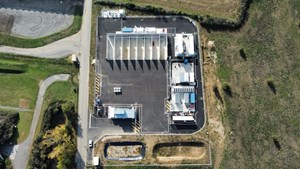News
Lhyfe and AREC Occitanie inaugurates green and renewable H2 production site in France
Lhyfe and AREC Occitanie (the regional energy and climate agency), are inaugurating the Lhyfe Occitanie site in the presence of Carole Delga, President of the Occitanie Region. This green and renewable H2 production site is one of the Region’s levers for achieving its objectives under the Occitanie H2 Corridor project, aimed at decarbonizing goods and passenger transport. The Lhyfe Occitanie production site is owned 80% by Lhyfe and 20% by AREC Occitanie. It will begin operating commercially in the first half of 2024.
Two years after its first site in the Pays de la Loire region, Lhyfe is inaugurating two new production units this month, in Occitanie and Brittany, thus confirming its promise of large-scale industrial deployment (five other sites are already under construction or expansion across Europe). These two new sites—each with five times the production capacity of the historic site—meet the growing market demand for green and renewable H2.
It is also an important week for the Occitanie Region, which is laying the first operational building blocks of its ambitious €150-MM Green H2 plan, announced in 2019. With the inauguration of Lhyfe Occitanie, the Region is launching the concrete deployment of the projects selected under the Occitanie H2 Corridor project.
At the Triangle business park in Bessières, a few dozen kilometers from Toulouse, Lhyfe Occitanie will now produce up to two tpd of green and renewable H2 (i.e., a production capacity from electrolysis of 5 MW), with the possibility of further ramping up production to keep pace with changing uses and needs. Two tons of H2 would enable a H2 truck to travel around 25,000 km, without emitting a single gram of CO2. With the equivalent quantity, a car could go around the earth five times, or travel around 200,000 km.
Lhyfe Occitanie H2 is produced through the electrolysis of water using renewable electricity. PPA (Power Purchase Agreement) contracts signed with renewable electricity producers (including VSB Energies Nouvelles and Kallista Energy) ensure the power supply.
The Lhyfe Occitanie production site is owned 80% by Lhyfe and 20% by AREC Occitanie. The Occitanie Region is coordinating the Occitanie H2 Corridor project. The project’s co-financiers are the European Union (with a €14.6-MM grant under the Transport part of the Connecting Europe Facility, known as CEF Transport Blending Facility or CEF TBF) and the European Investment Bank (through a €40-MM loan contracted by the Region). It is in this context that the Lhyfe Occitanie project was selected at the end of 2021 by the Occitanie Region following a call for projects. Under the program, Occitanie is providing €6 MM, including €4.1 MM as a repayable advance and €1.9 MM in grants.
The Occitanie H2 Corridor is part of the North–South European H2 corridor project, which aims to decarbonize goods and passenger transport on an axis running between the Mediterranean and the North Sea.
In accordance with the aims of the Occitanie H2 Corridor project led by the Region of Occitanie, this site will help to decarbonize transport by supplying green and renewable H2 to trucks, coaches and other fuel cell vehicles.
The aim of the Region with the Occitanie H2 Corridor is to have two renewable H2 production facilities by the end of 2024, initially representing a total 6 tpd of output, eight H2 fuel stations (delivering 600 kg/d–1,200 kg/d), 40 H2-powered trucks, 62 refrigerated trailers/units and 15 regional interurban buses retrofit to run on H2 which will be delivered in the first half of 2024.
Lhyfe Occitanie could also deliver the other refueling stations that will be built in the region. In addition, thanks to its scalable production capacity, this site will also meet the green and renewable H2 needs of industry (e.g., aeronautics and equipment manufacturing), transport/logistics providers and local authorities in the area wishing to rapidly decarbonize their mobility and/or processes.
Lhyfe’s semi-centralized model, which consists in producing locally and delivering throughout the region, means that all players can now have direct access to green and renewable H2 for their uses whether they need quantities that do not justify the construction of a site of their own, or want to trial using green and renewable H2 before considering a site of their own.
In 2021, in the very beginning of the green and renewable H2 industry, the Lhyfe Pays de la Loire production unit was designed as a showcase for this pioneering technology. In Bessières, Lhyfe is unveiling its new containerized format, which has the dual advantage of reducing the footprint of its sites and promoting their scalability to support the development of uses in the regions.
Lhyfe Occitanie—which occupies a site of around 8,000 sq. meters—comprises a series of containerized buildings devoted to various functions (driver reception, control room, electrical conversion, water electrolysis, compression, quality control, etc.), a truck circulation area and loading bays for trucks transporting H2 to distribution stations and various customers.




